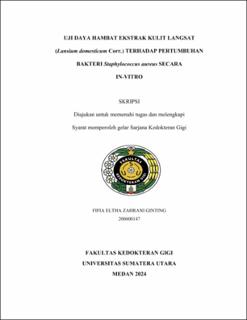Uji Daya Hambat Ekstrak Kulit Langsat (Lansium domesticum Corr.) terhadap Pertumbuhan Bakteri Staphylococcus aureus secara In-Vitro
Inhibition Test of Langsat Peel Extract (Lansium domesticum Corr.) against the Growth of Staphylococcus aureus Bacteria In-Vitro

Date
2024Author
Ginting, Fifia Eltha Zahrani
Advisor(s)
Siregar, Indra Basar
Metadata
Show full item recordAbstract
Due to the high rate of drug resistance, many people are using alternative herbal treatments to chemical-based drugs. The use of herbal medicine tends to have minimal side effects and can reduce resistance to antibiotics. Langsat peel is one of the natural ingredients that can be used as an antibacterial. Langsat skin contains compounds of flavonoids, terpenoids, alkaloids, saponins, steroids, and tannins that can function as antibacterials and inhibit Staphylococcus aureus bacteria. Staphylococcus aureus bacteria are one of the most common infections in the oral cavity and are gram-positive pathogenic bacteria. The purpose of the study was to determine the effectiveness of langsat peel extract against Staphylococcus aureus bacteria. Langsat peel extract with several concentrations, namely 1.56%, 3.125%, 6.25%, 12.5%, 25%, 50% positive control chlorhexidine gluconate 0.2% and negative control DMSO. Testing the bacterial inhibition of langsat peel extract using the Kirby-Bauer disc diffusion method. The data were subjected to Kruskal-Wallis test followed by Mann-Whitney test. In this study, there was a significant difference between the control group and the treatment group. The results showed that the diameter of the inhibition zone increased along with the increase in extract concentration.
Collections
- Undergraduate Theses [1900]
